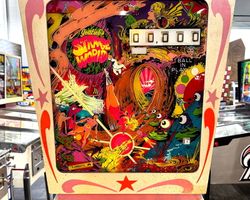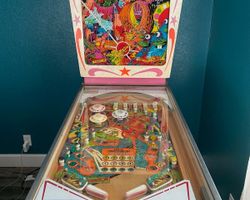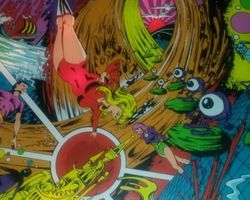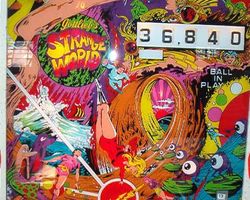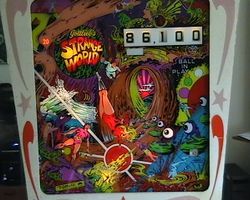Strange World
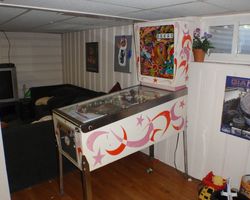
Average Prices: USD $200 to $3,300
Produced: Febuary, 1978
Production Run: 675 units
Machine Type: Electro-mechanical
Players: 1
Design by: John Osborne
Art by: Gordon Morison
"Strange World" emerged from D. Gottlieb & Company in February 1978, representing a pivotal moment in pinball history. As one of the final electro-mechanical (EM) pinball machines produced by Gottlieb before the full transition to solid-state technology, it encapsulates the culmination of decades of EM design principles alongside hints of the innovation to come. The machine was conceived by designer John Osborne, who would later contribute to the design of "Haunted House," and its distinct visual identity was crafted by artist Gordon Morison. The theme of "Strange World" leans into the fantastical and extraterrestrial, incorporating elements of sci-fi, outer space, and a bizarre, surreal vision of alien recreation.
Gottlieb produced 842 units of "Strange World," a relatively modest run for the era. This production total included 167 sample games produced in 1977, as well as 480 units for domestic sales and 195 for export, making it a notably rare pinball machine. The machine carries Model Number 414. Intriguing production details include the presence of "A.J.J." initials stamped on some playfield edges, a mark believed to refer to August Johnson Cabinet Company, a long-standing cabinet supplier for Gottlieb. This low production number, coupled with its late EM status, has contributed significantly to its high collectibility among pinball enthusiasts and collectors today.
Signature Features and Design
The most arresting aspect of the "Strange World" pinball machine is its art package. Gordon Morison's work on this title is consistently described as exceptional, characterized by its vibrant colors, intricate detailing, and a psychedelic, almost mind-melting, surreal aesthetic. The backglass in particular stands out, featuring a collection of "eyeball people" — ten on the backglass itself and six integrated into the playfield art — that perfectly encapsulate the machine's otherworldly theme. This unique visual style sets "Strange World" apart, evoking comparisons to distinctive comic book art for its bizarre and captivating imagery.
Beyond its striking visuals, "Strange World" distinguishes itself with an asymmetrical playfield layout, an unconventional design choice that aligns perfectly with its bizarre theme. This deliberate imbalance contributes to a distinctive gameplay experience, challenging players with varied shot angles and ball trajectories. The machine features two flippers, three pop bumpers, three slingshots, six standup targets, and a single kick-out hole. Notably absent for an EM game of its period are traditional drop targets, a design decision that forces a focus on other playfield elements. The auditory experience is anchored by Gottlieb's renowned chime units, which deliver crisp and satisfying sounds that complement the electro-mechanical action. A subtle 3D effect around the pop bumpers adds another layer of visual depth to the already rich artistic presentation.
Playfield and Mechanics
The "Strange World" playfield, while appearing deceptively simple at first glance, unfolds into a strategically deep and engaging environment. Its asymmetrical design is a key element, dictating a unique flow that rewards precise flipper control and skillful nudging. The central area is dominated by three pop bumpers, which, in conjunction with the slingshots positioned below them, create a rapid and unpredictable ball movement. Six standup targets are strategically placed around the playfield, often requiring skillful bank shots or direct hits to register. Additionally, there are six rollovers, contributing to the game's overall target count of twelve.
The artwork on the playfield reinforces the machine's surreal theme, with vibrant colors and alien figures integrated seamlessly into the playfield elements. Lighting, characteristic of EM machines, highlights the targets and scoring objectives, drawing the player's eye to the immediate goals. The outlanes are notoriously wide and challenging, demanding constant attention and well-timed nudges to prevent frustrating drains. This focus on ball control and nudging is a hallmark of rewarding EM gameplay, and "Strange World" exemplifies this necessity. The game’s design philosophy encourages players to understand and master its unique flow, leading to a highly immersive experience that pulls players deeper into its strange universe with each shot.
Gameplay Dynamics
The core objective in "Strange World" revolves around lighting numbers 1 through 4 across three different colors: red, yellow, and blue. Players achieve this by hitting specific standup targets and rollovers corresponding to these numbers and colors. The scoring system is intuitive yet provides depth. Completing a set of the same number across all three colors — for instance, hitting all three "1" targets regardless of color — lights those specific targets and rollovers for a substantial 5,000 points each, turning them into high-value scoring opportunities.
Further progression involves completing all numbers (1-4) within a single color. Successfully doing so activates the "special" mechanism, located at the left saucer, which awards replays. A distinctive feature is the rotating nature of this special; it cycles between the three colors. As a player completes more full color sets, the frequency of the special activating for those completed colors increases, offering more opportunities for replays. Once all three colors are completed, the special remains continuously lit, allowing for a "scorefest" if the player maintains control. While this can lead to high scores, a notable characteristic of the machine is its score display maximum of 199,990 points, requiring players to mentally track scores beyond that limit during extended play sessions. The game demands precise shooting and active nudging, especially given its challenging outlanes, making consistent high scores a testament to player skill and strategic execution.
Reception and Legacy
"Strange World" has garnered a very positive reception within the pinball community, particularly among enthusiasts of electro-mechanical machines. Its primary strength lies in its singular and captivating art package, which is frequently lauded as one of Gottlieb's finest artistic achievements. The surreal, psychedelic visuals of both the backglass and playfield are often cited as the main draw, creating an immediate and lasting impression. This visual appeal is complemented by the machine's engaging gameplay, described as addictive and rewarding. Reviewers frequently highlight the game’s challenging shots and the well-thought-out playfield layout, which despite its asymmetrical nature, offers strategic depth and requires effective ball control and nudging. The quality of Gottlieb's chime units also adds to the nostalgic and satisfying auditory experience. Its status as a rare and collectible EM, due to its low production numbers, further enhances its desirability.
However, "Strange World" is not without its noted points. Some players find that once the primary scoring objectives—lighting the numbers and colors—are achieved, the gameplay can become somewhat straightforward, leading to extended "scorefest" sessions. While this can be enjoyable, it has led to some characterizing the strategy as potentially "one-dimensional." The absence of drop targets, a staple for many EM games of the period, is also occasionally mentioned, though most players find the existing targets and rollovers sufficient. Specific feedback has pointed to the positioning of certain rollovers, such as the Yellow #4 and Yellow #2 targets, as slightly less intuitive than other elements. Despite these minor criticisms, the overall consensus remains strongly positive. "Strange World" holds a respected place as a late-era Gottlieb EM that pushed artistic boundaries and delivered a unique and challenging play experience. Its influence is evident in its continued collectibility and its status as a machine that perfectly encapsulates the charm and mechanical ingenuity of the EM era just as the industry was preparing for a technological shift.
Sponsored Links
 Ebay Listings
Ebay Listings
 Auction Results
Auction Results
| Cost | Location | Date |
|---|---|---|
| USD $4,500 |  Massachusetts, United States Massachusetts, United States |
17 April, 2025 |
| USD $2,600 |  California, United States California, United States |
18 December, 2022 |
| USD $2,400 |  Pennsylvania, United States Pennsylvania, United States |
19 August, 2022 |
| USD $5,200 |  Maryland, United States Maryland, United States |
26 March, 2022 |
| USD $3,200 |  California, United States California, United States |
27 December, 2021 |
| AUD $7,700 |  Victoria, Australia Victoria, Australia |
28 March, 2021 |
| USD $3,500 |  Canada Canada |
30 January, 2021 |
| USD $6,399 |  Michigan, United States Michigan, United States |
25 December, 2020 |
| USD $3,699 |  California, United States California, United States |
10 December, 2019 |
| USD $3,802 |  Nebraska, United States Nebraska, United States |
30 July, 2019 |


Private Policy · Search Website · Contact Us
As an eBay Partner, we may earn a commission from qualifying purchases made through links on this site, at no additional cost to you.
All trademarks and copyrighted materials remain property of their respective owners. All other content copyright 2007 - 2025 Pinpedia.

